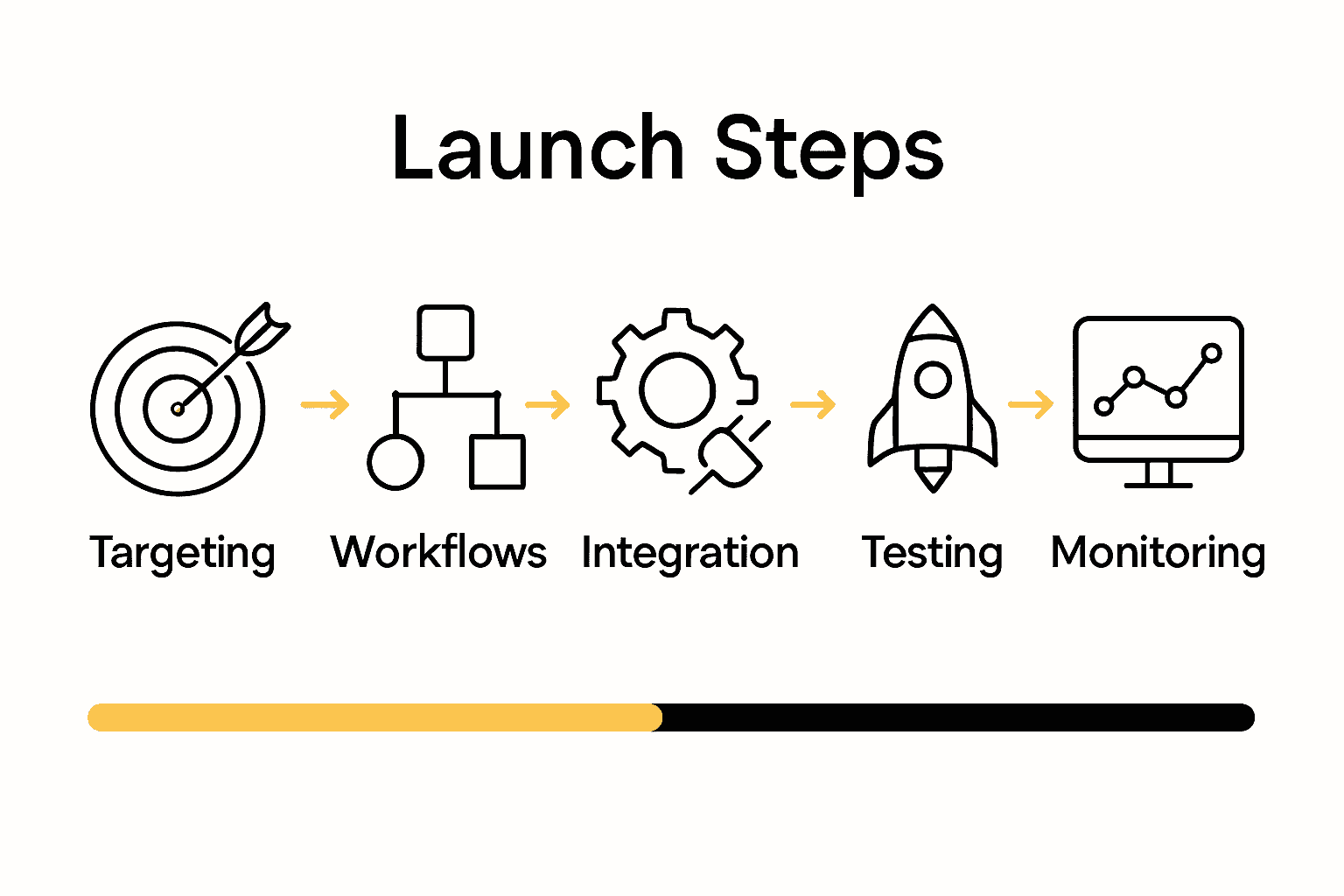23.10.25

Did you know that over 70 percent of new insurance products fail to achieve lasting market traction? Every missed step can cost time and trust in an industry where customer needs evolve fast. Understanding the full product launch process, from defining requirements to real-time performance monitoring, can make the difference between a standout success and an early dropout. This guide explains how insurers can map each phase for maximum impact and long-term customer loyalty.
Table of Contents
- Step 1: Define Product Requirements And Digital Goals
- Step 2: Configure Insurance Workflows And Rating Models
- Step 3: Integrate Distribution Channels And Ecosystem Partners
- Step 4: Test And Validate Product Across All Touchpoints
- Step 5: Deploy And Monitor Product Performance Post-Launch
Quick Summary
| Key Point | Explanation |
|---|---|
| 1. Clearly define customer segments | Conduct in-depth research to identify unique needs based on demographics to inform product development strategies. |
| 2. Develop flexible workflows and rating models | Create adaptable processes that can adjust to market conditions and ensure accurate risk assessment for pricing. |
| 3. Build a strong distribution network | Integrate effective channels and empower partners with tools to enhance customer engagement and support their efforts. |
| 4. Rigorous testing and validation required | Ensure compliance and functionality by simulating various scenarios and gathering feedback before market launch. |
| 5. Implement ongoing performance monitoring | Establish real-time tracking of product metrics to quickly identify and address any emerging issues post-launch. |
Step 1: Define product requirements and digital goals
In this step, you will map out the strategic blueprint for your insurance product launch by identifying precise customer needs and establishing clear digital objectives. Your goal is to create a laser-focused roadmap that transforms market insights into actionable product development strategies.
Starting with customer segmentation is crucial. According to research from Boston Consulting Group, insurers must divide the market into distinct groups and deeply understand their unique requirements. This means developing target segments based on sociodemographic factors like age, income, lifestyle, and specific insurance protection needs.
To build an effective product strategy, you will need to develop an operational plan for each customer segment. This involves determining the specific value proposition that will resonate most powerfully with each group. What problems are you solving? What unique benefits will your insurance product provide?
A key part of this process is designing a comprehensive go-to-market strategy. According to McKinsey, successful insurers integrate protection, prevention, customer engagement, and innovative distribution approaches. This means thinking beyond traditional insurance models and creating holistic solutions that truly address customer needs.
Pro Tip: Create detailed customer personas for each segment. Include their pain points, financial goals, risk tolerance, and digital behavior patterns.
By the end of this step, you will have a clear understanding of your target market, their specific requirements, and a strategic framework for developing a digital insurance product that meets their needs. Your next step will involve translating these insights into specific technical and design requirements.
Step 2: Configure insurance workflows and rating models
In this critical step, you will design the operational backbone of your insurance product by configuring precise workflows and rating models that determine how your product will function and price risk. Your goal is to create a flexible system that can adapt quickly to market changes and regulatory requirements.
Configuring workflows involves mapping out every step of your insurance process from initial quote to policy issuance and claims management. According to research from Zov Solutions, flexible configuration tools allow carriers to adapt to market demands, regulatory changes, and diverse customer needs. This means building a system that can accommodate different regulatory requirements across regions and support multi-currency and multi-language configurations.

Rating models are the engine of your insurance product. They determine how risk is assessed and priced for different customer segments. You will need to develop mathematical models that accurately calculate premiums based on various risk factors such as age, location, historical claims data, and specific customer characteristics. These models must be precise enough to protect your business while remaining competitive in the market.
Operational process testing is crucial during this phase. As Root Platform notes, ensuring that all operational processes are thoroughly tested can lead to a faster launch with fewer unexpected challenges. This means simulating different scenarios, stress testing your workflows, and verifying that every step functions as intended.
Pro Tip: Build flexibility into your workflows from the start. Design your rating models and processes to be easily adjustable as market conditions change.
By the end of this step, you will have a robust, configurable system that can price risk accurately, process transactions efficiently, and adapt quickly to new market opportunities. Your next step will involve rigorous testing and validation of these newly created workflows and rating models.
Step 3: Integrate distribution channels and ecosystem partners
In this pivotal step, you will design a comprehensive strategy for connecting your insurance product with the right distribution networks and strategic partners. Your goal is to create a robust ecosystem that amplifies your product’s reach and delivers exceptional value to customers.
Building an effective InsurTech ecosystem requires a customer-centric approach. According to research from MDPI, successful integration involves designing products that are innovative and closely aligned with customer needs and behaviors. This means understanding how technology can enhance user experience and create more personalized insurance services.
To effectively integrate distribution channels, you need to provide comprehensive support for your partners. InsurTech Insights highlights that successful integration involves equipping agents with powerful back-end tools. These include AI-powered rating systems, compliance tools, digital marketing assistance, and process automation technologies that enable partners to focus on building customer relationships.
When selecting ecosystem partners, look beyond traditional metrics. Evaluate potential partners based on their technological capabilities, customer alignment, and ability to deliver seamless experiences. Consider factors like their digital maturity, customer engagement strategies, and willingness to collaborate on innovative solutions.
Pro Tip: Develop clear integration protocols and provide comprehensive onboarding support to ensure smooth collaboration with your distribution partners.
By the end of this step, you will have a well-designed distribution network that extends your product’s market reach and creates multiple touchpoints for customer engagement. Your next step will involve implementing robust technological infrastructure to support these partnerships.
Step 4: Test and validate product across all touchpoints
In this critical validation phase, you will systematically test your insurance product to ensure it meets regulatory standards, performs flawlessly, and delivers an exceptional customer experience across every interaction point. Your objective is to identify and resolve potential issues before a full market launch.
According to research from Insure Niche, the testing and validation stage requires rigorous scrutiny to identify potential problems before going live. This involves gathering comprehensive feedback from test markets and key stakeholders to confirm that your product fulfills regulatory compliance and meets consumer expectations effectively.
Your testing strategy should encompass multiple dimensions. This means thoroughly examining technical functionality, user experience, pricing models, and regulatory compliance. Simulate various customer scenarios to understand how your product performs under different conditions. Test your digital interfaces, quote generation systems, policy management workflows, and claims processing mechanisms to ensure seamless operation.
Post launch monitoring is equally important. As Root Platform notes, hidden risks can emerge if people and teams do not fully adopt the change. This means not just testing the technical aspects but also ensuring that your sales teams are prepared, enablement assets are effective, and operational processes are robust.
Pro Tip: Create a comprehensive test matrix that covers technical performance, user experience, compliance requirements, and potential edge cases before final deployment.
By the end of this step, you will have a thoroughly validated insurance product ready for market introduction. Your next step involves preparing for a strategic and controlled product launch that minimizes risks and maximizes market potential.
Step 5: Deploy and monitor product performance post-launch
In this crucial final stage, you will strategically roll out your insurance product and establish a robust monitoring system to track its performance, gather critical insights, and make data-driven adjustments. Your primary objective is to ensure successful market adoption while maintaining the ability to quickly respond to emerging challenges.
According to research from Shield Ana, effective launch strategies require careful planning, targeted marketing, and strategic stakeholder engagement. This means developing a comprehensive plan that includes precise market segmentation, carefully selected communication channels, and well-designed distribution tactics that maximize product adoption and build customer trust.
Establishing a sophisticated feedback mechanism is essential. You will need to implement real-time monitoring systems that capture customer responses, track key performance indicators, and provide early warning signals for potential issues. This involves collecting data across multiple touchpoints including customer service interactions, digital platform usage, claims processing times, and overall customer satisfaction metrics.
Root Platform emphasizes that post-launch monitoring goes beyond technical stability. Hidden risks can emerge if your internal teams and sales channels do not fully embrace the new product. This means continuously engaging with your distribution partners, providing ongoing training, and ensuring that sales enablement resources remain current and compelling.
Pro Tip: Create a dynamic dashboard that visualizes key performance metrics in real time, enabling rapid identification and resolution of emerging challenges.
By the end of this step, you will have a comprehensive understanding of your product’s market performance and the agility to make swift, informed adjustments. Your ongoing mission is to continuously refine and optimize your insurance product based on actual market feedback and evolving customer needs.

Here’s a summary of each step and its primary focus:
| Step | Main Objective | Key Activities |
|---|---|---|
| 1. Define product requirements | Understand customer needs | Segment customers Set digital goals Develop value propositions |
| 2. Configure workflows & models | Build operational backbone | Map workflows Create rating models Test processes |
| 3. Integrate distribution & partners | Expand market reach | Select channels Equip partners Set integration protocols |
| 4. Test & validate product | Ensure readiness & compliance | User testing Compliance checks Scenario simulation |
| 5. Deploy & monitor | Achieve successful launch | Market rollout Monitor KPIs Gather feedback |
Accelerate Your Insurance Product Launch with Proven Technology
Launching a new insurance product quickly while ensuring accuracy, compliance, and seamless customer experience is no easy feat. The article highlights key challenges such as configuring flexible workflows, building precise rating models, integrating distribution channels, and conducting thorough testing. These steps are critical but often complex when relying on fragmented legacy systems.
Insurance Business Applications (IBA) understands these pressures. With our cloud-native, API-first platform, IBSuite, you have everything you need to streamline your entire insurance value chain. From underwriting and rating to claims and billing, IBSuite supports rapid product innovation and simplifies adaptation to shifting market demands. This empowers your team to move from concept to launch faster with confidence and full regulatory compliance.
Ready to transform your product launch strategy? Discover how IBSuite can help you build flexible workflows, integrate partners effortlessly, and monitor performance in real time by scheduling a personalized demo today. Don[NULL]27t wait for market changes to define your pace. Take control of your product success with Insurance Business Applications. Explore the full capabilities of our platform and see why top insurers trust IBSuite for speedy innovation and scalable growth. Get started now by booking your demo at Book a Demo.
Frequently Asked Questions
What are the key steps to successfully launch an insurance product?
The key steps to launch an insurance product include defining product requirements, configuring workflows and rating models, integrating distribution channels, testing and validating the product, and monitoring performance post-launch. Start by mapping out customer needs and digital goals to guide your entire process.
How can I identify the right customer segments for my insurance product?
To identify the right customer segments, analyze sociodemographic factors such as age, income, lifestyle, and specific insurance needs. Create detailed customer personas that outline their pain points and financial goals, giving you a clear focus for product development.
What should I include in my product’s operational workflows?
Your operational workflows should map every step from quoting to claims management, ensuring each process is clear and efficient. Begin by outlining each stage and establishing testing protocols for accuracy and compliance before launching your product.
How do I choose the right distribution partners for my insurance product?
Select distribution partners by evaluating their technological capabilities and alignment with customer needs, focusing on their ability to provide innovative solutions. Create clear integration protocols and offer onboarding support to enhance collaboration and streamline processes.
What testing strategies should I use before launching my insurance product?
Implement a comprehensive testing strategy that examines technical functionality, user experience, and regulatory compliance. Simulate customer scenarios to identify potential issues and conduct thorough scenario testing to ensure readiness before going live.
How do I monitor the performance of my insurance product post-launch?
Monitor your insurance product’s performance by setting up a real-time feedback system that tracks key performance indicators and customer satisfaction metrics. Establish regular check-ins and adjust your strategies based on market feedback within the first few months after launch.
Recommended
- Solving Product Development Challenges – Digital Insurance Platform | IBSuite Insurance Software | Modern Insurance System
- Why is insurance product management critical to obtain speed to value for insurers? – Digital Insurance Platform | IBSuite Insurance Software | Modern Insurance System
- Embedded Insurance and its Importance: Part 1 – Digital Insurance Platform | IBSuite Insurance Software | Modern Insurance System
- Digital Embedded Microinsurance Strategy: Keys for Success – Digital Insurance Platform | IBSuite Insurance Software | Modern Insurance System